Lal R., Shukla M.K. Principles of Soil Physics
Подождите немного. Документ загружается.

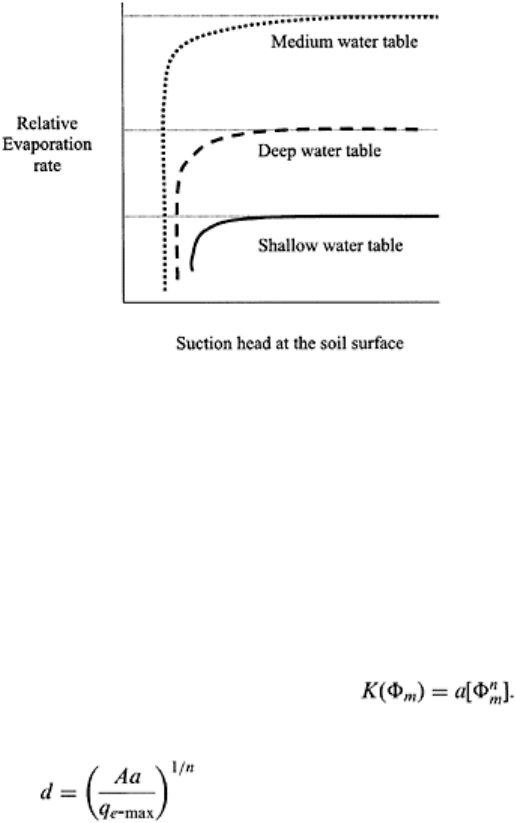
FIGURE 15.2 Steady rate of upward
flow and evaporation from a water
table as a function of the suction
prevailing at the soil surface. The soil
is sandy loam with n=3 (Modified
from Gardner, 1958.)
steady rate of evaporation depends on the depth of this water table. The maximum
possible evaporation for a ground water table at z will be for the lowest water content at
the soil surface. Under this situation suction will tend to be infinite (pressure head infinity
with negative sign). However, the extraction of water from soil profile is limited by the
capacity of soil profile to transmit water or in other words by the hydraulic conductivity
of soil. Ignoring the constant b, in Eq. (15.7), which leads to
Gardner
(1958) derived the following relationship between the depth of water table (d) and the
maximum or limiting rate of transmission of water (q
max
) by soil to the surface layer
(15.10)
where A is a constant and is a function of n and q
e-max
, a and n are constants from Eq.
(15.7). Equation (15.10) shows that evaporation and depth of water table are inversely
related. Gardner (1958) showed that the evaporation rate from the soil is dependent on
soil texture and is greater from medium textured soils as compared to the coarse textured
soils (Fig. 15.3). Value of n is greater in coarse textured soils as compared to fine
textured soils and therefore maximum evaporation rate
Principles of soil physics 414

FIGURE 15.3 Schematic of
evaporation rate as affected by texture
of soil (water table depth, 60 cm).
(Modified from Gardner, 1958.)
decreases more rapidly with depth in coarse textured soils as compared to the fine ones.
15.4.2 Evaporation in the Absence of a Water Table
Evaporation from soils in the absence of a water table is a transient process. Steady
evaporation from soils is not always true because water table depths do not always
remain constant for very long time. Therefore, a transient process describes the
evaporation from soil surface more realistically. The transient condition implies that
water content of soil profile does not remain constant, instead it decreases with
evaporation as soil becomes drier. Another common assumption for steady state
evaporation is that the external conditions (i.e., atmospheric evaporativity) remain
constant, which is seldom true. However, for the sake of simplicity, constant atmospheric
evaporativity is generally assumed for describing transient evaporation from the soil
surface.
The process of transient evaporation or drying is already described as having three
stages: initial constant rate stage, falling rate stage, and slow rate stage (Fig. 15.4). It is
clear from Fig. 15.4 that the transition from the first to second stage of drying is sharp.
However, transition from second to third stage is gradual and difficult to separate. In the
initial stage of drying soil moisture depletion on the soil surface is compensated by soil
underneath and evaporation remains by and large constant. Gradually, suction gradient
inside the soil becomes larger with corresponding decrease in soil
Soil water evaporation 415
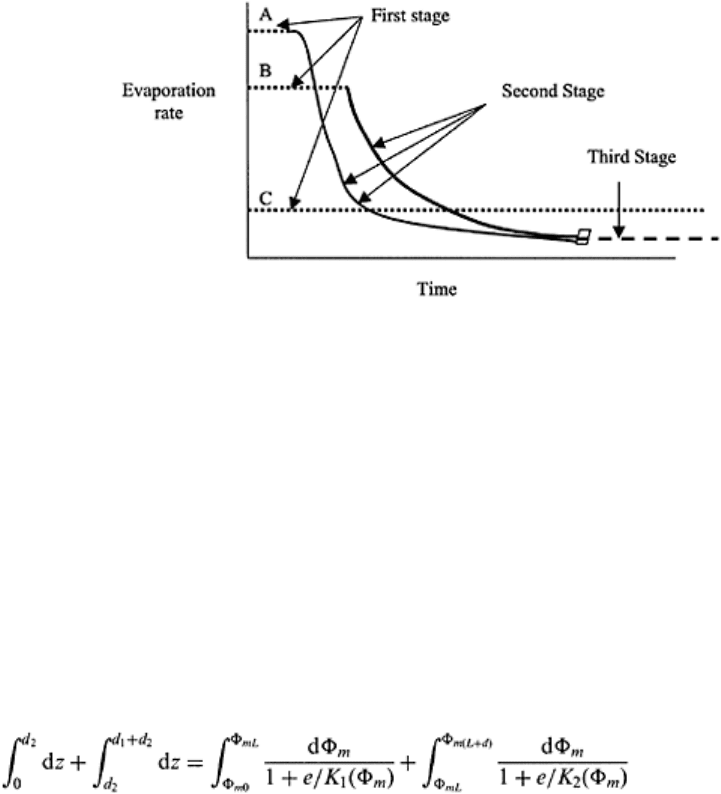
FIGURE 15.4 Stages of evaporation
from a soil during steady atmospheric
condition.
conductivity. This results in a decrease in evaporation rate with respect to time. The
length of time the initial stage of drying can go on depends on the evaporativity. A low
evaporativity will increase the duration of first stage of drying.
15.4.3 Evaporation from Layered Soils
Steady evaporation from layered soils can be determined similar to that from a
homogeneous profile. Willis (1960) carried out the analysis by assuming that steady flow
through layered profile depends upon the transmission property of soil. He further
assigned that the suction or matric potential is continuous through the entire soil profile,
although water content and conductivity are discontinuous using the relationship between
K(Φ
m
) and Φ
m
[Eq. (15.7)] (Gardner, 1958) and assuming that each layer is internally
homogeneous, he proposed the following relationship:
(15.11)
where d
1
and d
2
are the thickness of top and bottom layers respectively. Eq. (15.11)
relates depth of water table to suction for a given evaporation rate. The limiting
evaporation rate for a known water table depth can be calculated from above equation by
assuming the suction (Φ
m
) to
Principles of soil physics 416
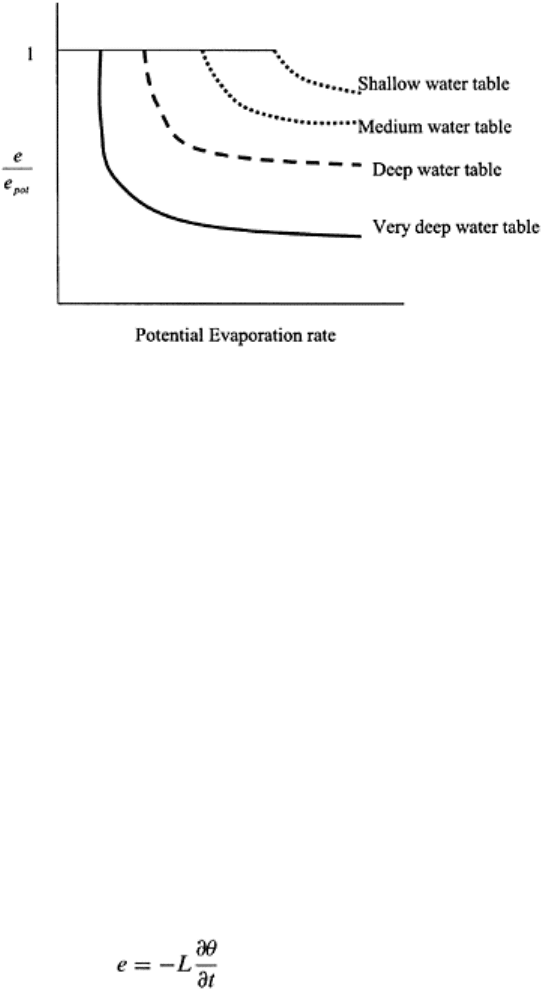
FIGURE 15.5 Dependence of relative
evaporation rates, (e/e
pot
) upon
potential evaporation rate
(evaporativity, e
pot
) for a clay soil.
Numbers labeling the curve indicate
the depth to water table (cm).
(Modified from Ripple et al., 1972.)
be infinite at soil surface. Ripple et al. (1972) proposed a graphical method to measure
the steady state evaporation from a multilayer soil profile. They included both the soil
properties (i.e., water retention and transmission, vapor flow, depth of water table) and
the meteorological factors (i.e., humidity, air temperature, and wind velocity) (Figs. 15.5
and 15.6).
15.4.4 Mathematical Modeling of Stages of Drying
The difference in suction at soil surface and a location with the soil body supplying water
is much higher as compared to the depth of soil involved in the process of drying.
Therefore, gravity effects are generally neglected for evaporation calculations. Most
analysis is based on soil water content and the hydraulic diffusivity relationship. The first
and second stages of drying depend upon the hydraulic diffusivity. In order to derive
approximate description of drying in the first stage (Fig. 15.6), Gardner (1959) assumed
that the evaporation rate from a soil profile of depth (L) could be expressed as
(15.12)
Soil water evaporation 417

FIGURE 15.6 Effect of horizonation
and water table depth on the
evaporation rate: (a) limiting curve for
soil water evaporation from for
homogeneous soil; (b) a two-layer soil
with the upper layer thickness of 3 cm;
(c) thickness 10 cm; (d) a three-layer
soil with thickness of intermediate and
uppermost layers equal to 10 cm each.
(Modified from Ripple et al., 1972.)
if the soil water diffusivity (D(θ)) can be expressed by the following relationship
(Gardner and Mayhugh, 1958)
D(θ)=D(θ)
0
exp[β(θ−θ
0
)]
(15.13)
where D(θ)
0
correspond to θ
0
and β ranges from 1 to 30. Gardner (1959) combined Eqs.
(15.12) and (15.13) and after further approximation proposed that the total water content
of soil profile can be approximated by the following relationship:
(15.14)
and
(15.15)
Principles of soil physics 418
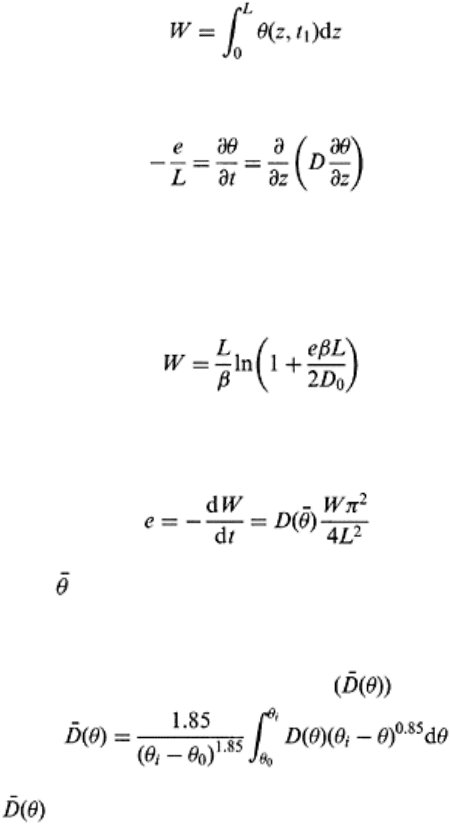
where W is the water storage in the entire soil profile at the end of first stage t =t
1
.
(15.16)
Gardner and Hillel (1962) also assumed that the evaporation rate from soil profile is
given by Eq. (15.12) and the flow equation as follows
(15.17)
where z is the height above the bottom of soil profile. Eq. (15.17) was integrated once.
The constant of integration was assumed zero since flow through bottom of the soil
profile (z =0) is zero. Assuming D can be represented by Eq. (15.13), Gardner and Hillel
(1962) found that actual evaporation rate ceases to be equal to potential rate when at z=L,
θ=θ
0
. They proposed the following equation for total water content (W) of profile.
(5.18)
For a long soil column dependence of e on t is only approximately valid. For a soil
column of finite length (L), Gardner and Hillel (1962) proposed the following
relationship to calculate evaporation during second stage (Fig. 15.5).
(15.19)
where
is average water content, the D(θ) is known diffusivity function. Eq. (15.19) can
be integrated to obtain cumulative infiltration.
Gardner (1959) presented the analytical solution for the second stage of evaporation
by using the solution for diffusion by Crank (1956). According to Crank (1956), the
weighted mean diffusivity for desorption
is
(15.20)
where for sorption process is higher than that for desorption process. The weighing
is done differently because in infiltration maximal flux occurs at the wet end of column,
where diffusivity is the highest. However, in drying the greatest flux is through the dry
end, where diffusivity is the lowest. This is also the reason, why sorption processes are
faster as compared to desorption. Gardner (1959) assumed that initial evaporation is
infinitely high and soil surface is instantaneously brought to the final stage of drying.
Therefore, e
pot
→∞, at t=0 when second stage of drying starts. Using the diffusivity form
of Richards’ equation and assuming that influence of gravity is negligible, the
evaporation rate for a semi-infinite soil column can be given as
Soil water evaporation 419
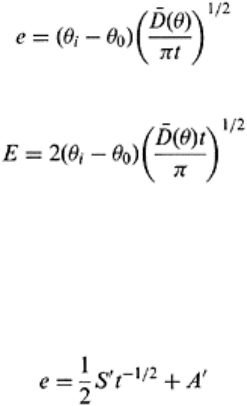
(15.21)
and cumulative evaporation (E) can be given as
(15.22)
Using the sorptivity concept of Philip (1975), Rose (1966) presented the following
relationship for evaporation calculation in the second stage of drying:
E=S′ t
1/2
+A′t
(15.23)
or
(15.24)
where S′ is the soil evaporativity (which is equivalent to soil water sorptivity in
infiltration, since the process is drying it can be termed as desorptivity, LT
−1/2
) and A is a
constant (LT
−1
comparable to trasmissivity [see Eq. (14.24)]). The value of S′ is positive
whereas b is negative. The assumption of a zero flux at the bottom of the profile or at
depth L, although simple, implies that in the absence of this condition evaporation will
accompany redistribution. This will reduce both the evaporation rates and the duration of
the first stage. Solutions of evaporation considering isothermal conditions differ from the
nonisothermal condition. The concept of three stages of evaporation does not strictly hold
in field conditions (Jackson et al., 1973). The diurnal temperature fluctuations and other
atmospheric process largely affect the evaporation rate. When air temperatures are low
the upward heat flow is accompanied with water flow. When temperatures are high, the
downward heat flow is accompanied with water flow and/or vapor flow. All these effects
make sure that the second stage of drying starts well before the moisture content of soil
has reached hygroscopic coefficient or the final dry value. Another factor, which can
influence evaporation by as much as 50% is the presence of cracks in the soil. The cracks
or similar soil inhomogeinities have totally different thermal fields compared to
homogeneous soils. Downward vapor flow due to thermal gradients is observed within
the cracks of small sizes (Hatano et al., 1988). The cracks may not increase the
evaporation rate during the early stage of drying, but can increase the duration of that
stage. Cracks can also increase the evaporation rate of subsequent profile controlled
drying period (or second stage).
15.4.5 Nonisothermal Evaporation
The isothermal flow equation is assumed to predict the constant and falling rate of
evaporation reasonably well. The role of nonisothermal conditions is explained by
comparing the solutions of an isothermal process to the solutions of nonisothermal
process (Milley, 1984). According to Jackson et al. (1974), in wet soils the thermal and
Principles of soil physics 420
isothermal vapor fluxes are approximately equal and opposite in direction for diurnal
variation of temperature. For a dry soil surface layer, the thermal vapor pressure increases
the evaporation from soil profile during night. However, neglecting thermal effects over a
month introduce only about 1% error.
15.5 MANAGEMENT OF EVAPORATION
Evaporation from bare soil surface needs to be reduced so that moisture status of soil can
be maintained at a stage favorable for crop growth and production. The evaporation
management can be done by: (i) reducing the total amount of incident radiations or
sources of energy responsible for evaporation; (ii) modifying the color of soil by applying
amendments and changing the albedo parameters; and (iii) reducing the upward flux of
water by either lowering the water table, or decreasing the diffusivity and conductivity of
the soil profile. The methods of evaporation reduction from bare soils depend on the
stage of drying. The first stage requires modifications, which will alter meteorological
conditions of the surroundings. The second stage requires measures, which will change
water transmission properties of the soil profile. Covering or mulching the surface with
vapor barriers or with reflective materials can reduce the intensities of the incoming
radiations and reduce the evaporation in the first stage of drying. A deep tillage may
change the variation of diffusivity with changing water content of soil profile and may
change the rate at which water can be supplied to the soil surface from underneath for
evaporation.
15.5.1 Mulching
Mulch is any material placed on a soil surface primarily to cover the surface for the
purpose of reducing evaporation, controlling weeds, and obtaining beneficial changes in
soil environment. The other benefits of mulching are: (i) reducing soil erosion; (ii)
sequestering carbon; (iii) providing organic matter and plant nutrition; (iv) regulating and
moderating soil temperature; (v) increasing earthworm population and improving soil
structure; and (vi) reducing soilborne diseases.
Mulches can consist of many different types of materials, such as sawdust, manure,
straw, leaves, crop residue, gravels, paper, and plastic sheets, etc. (Fig. 15.7) (Lal, 1991).
Paper or plastic mulches, especially light colored, are effective in reducing the effects of
meteorological variables, which influence the evaporative demand during the first stage
of soil evaporation (Figs. 15.8 and 15.9). Black paper and plastic mulches are effective in
weed control (Fig. 15.10). The temperature of the soil under plastic mulch can be 8 to
10°C higher than under straw mulch. Soil thermal regime is a function of the contact
coefficient, which is a product of thermal conductivity and volumetric heat capacity of
the soil (refer to Chapter 17). A mulched plot with dry crop residue is equivalent to a
two-layered profile of which the upper layer has a lower contact coefficient. Therefore,
temperature variations in the soil underlying the mulched layer are reduced (Figs. 15.11
and 15.12). High temperature may be beneficial to the crops on temperate regions during
germination in spring. However, high temperature during summer and in the tropics may
adversely affect the growth of temperature-sensitive crops. Other mulch materials may
Soil water evaporation 421
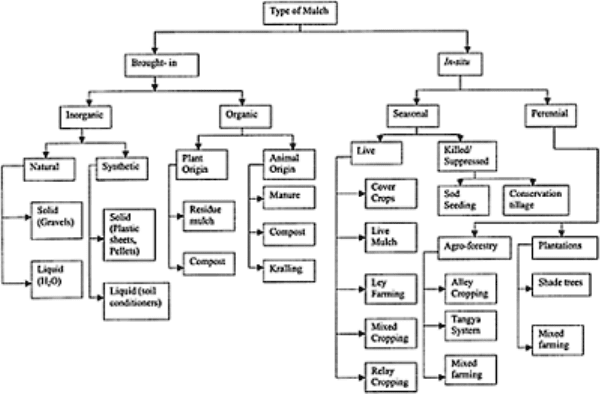
include preparations of latex, asphalt, oil, fatty acids, and alcohols. These materials can
be used as mulches for reducing evaporation from soil surface. Hillel (1976) proposed
that uppermost layer of soil be formed by clods or a rough seedbed, which are treated
with water proofing materials (e.g., silicones). These waterproof clods act as dry mulch
and reduce evaporation and erosion from soil surface.
Vegetative mulch must have sufficient thickness to be effective in reducing
evaporation and risks of soil erosion. The porosity and hydraulic conductivity of the
vegetative mulches are high, and therefore diffusion or
FIGURE 15.7 Type of mulches on the
basis of the source of the material.
(Modified from Lal, 1991.)
Principles of soil physics 422
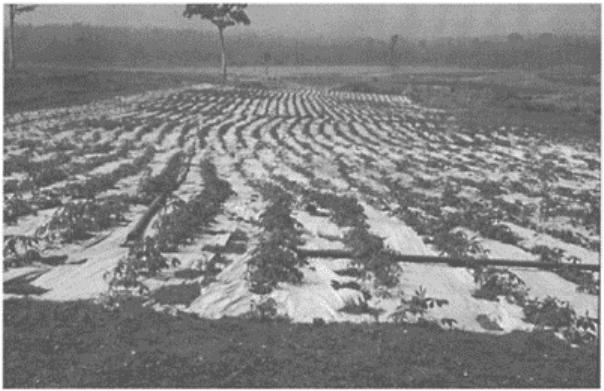
FIGURE 15.8 Clear plastic mulch
used on cassava grown at IITA in
western Nigeria to conserve soil water.
Soil water evaporation 423
